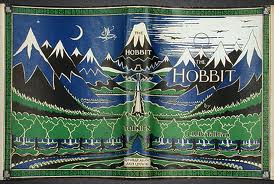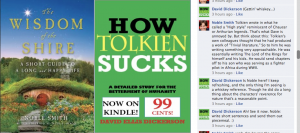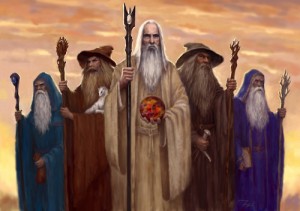This blog was first published last year (2012) on the 75th anniversary of the publication of The Hobbit.
“In a hole in the ground there lived a hobbit.”
September 21st is the 75th anniversary of the publication of The Hobbit. J.R.R. Tolkien, as the story goes, scribbled the first line of his now famous book while taking a much-needed pause from grading English papers. The words came to him in a flash of insight—an epiphany that would change literature forever and create a whole new genre of serious fantasy, leaving behind “the gimcrack of conventional modern fairy-tales” that Tolkien so despised (think early Disney films).
But The Hobbit would never have been published if not for the recommendation of a ten-year-old. Rayner Unwin, son of the publisher Stanley Unwin, was handed a manuscript of The Hobbit by his father and paid a shilling to write a report on it (one shilling was decent pocket-change for a kid back in the 30’s). Rayner enjoyed Tolkien’s book and wrote, “…it is good and should appeal to all children between the ages of 5 and 9.” And that was enough for his father. It is one of the great ironies of publishing history that an Oxford professor’s book was given the go-ahead based simply upon the vanilla recommendation of a schoolboy.
In 1937 Hitler was on the rise in Europe. The Japanese invaded China. The Spanish Civil War raged. The inaugural NFL game was played. Charlie Chaplain’s first “talkie” motion picture came out in theaters. And The Hobbit was printed with an initial run of just 1,500 copies—predating the release of Disney’s Snow White (a film with seven whistling “Dwarfs” as opposed to thirteen ferocious “Dwarves”) by exactly three months.
The next year Tolkien started work on his unnamed “sequel” to The Hobbit. He sent the first chapter to his publisher who, of course, passed “A Long-expected Party” to none other than young Rayner who was now eleven. The publisher-in-training enjoyed the chapter but complained there was too much “hobbit-talk.” Ha!
Nearly fifteen years went by. Tolkien worked diligently on The Lord of the Rings all that time, typing out the entire 600,000 word manuscript by himself. Twice. (And typing with only two fingers) He found a publisher, and then became furious when the publisher kept stalling on the release date, and he withdrew the manuscript in a fit of pique that he soon regretted most terribly. Thankfully Rayner—now an adult and working for the family publishing company—reappeared on the scene with the good timing of a wizard, and asked if he might see the manuscript. The rest is publishing history. (Christopher Tolkien, by the way, still uses his father’s typewriter and composed all twelve volumes of The History of Middle-earth on it and even The Silmarillion.)
Rayner shepherded Tolkien through the arduous process of getting The Lord of the Rings ready for publication. It was Rayner’s idea to divide the massive book into three parts, much to Tolkien’s annoyance (Peter Jackson is not the first to split one of Tolkien’s books into a trilogy). The author’s exchanges with Rayner (in The Letters of J.R.R. Tolkien) during this period are a wonderful and amusing window into their fascinating relationship. Tolkien is like a cantankerous but lovable Bilbo dealing with Frodo, arguing about the titles for the books (he did not like the name The Two Towers one bit), and complaining comically about finalizing the map of Middle-earth, “This map is hell!”
About a year and a half before Tolkien died he sent a letter to Rayner saying, “Everything you do for me fills me with gratitude.” He asked Rayner to please start addressing him as “Ronald”—his Christian name. This was a great honor and a mark of respect coming from someone brought up in Tolkien’s world, where even dear friends called each other by their initials: an ingrained holdover of Victorian formality. Rayner was not only Tolkien’s very old friend, he was also his literary champion and, fortunately (for all of us Tolkien fans) he had had the good sense as a ten-year-old to approve of The Hobbit. If he had not, the manuscript might have spent the last seventy-five years collecting dust, rather than living all this time in the hearts and minds of tens of millions of fans around the world.
UPDATE (9/21/13): Read my review of the new edition of The Hobbit with 150 new illustrations by artist Jemima Catlin.



